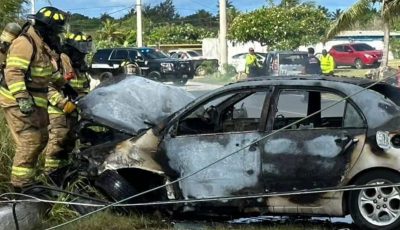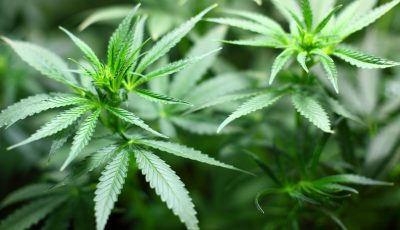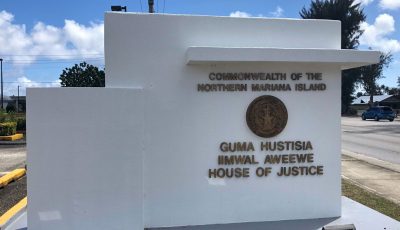‘Crisostomo DNA matched Romero samples’
IT&E records corroborate testimony about Crisostomo using Kintaro cell phone
A Federal Bureau of Investigation forensic examiner in the nuclear DNA unit at the FBI Lab in Quantico, Virginia, testified yesterday that Joseph A. Crisostomo’s DNA matched the DNA obtained from swab samples taken from the vagina of murdered bartender Emerita R. Romero.
Testifying for the CNMI government in the ongoing jury trial of 40-year-old Crisostomo in Superior Court, FBI forensic examiner Susannah Kehl disclosed that she tested the sexual assault kit that the FBI Saipan Office sent to their laboratory and that she concluded the positive presence of semen in Romero’s vagina.
James Calderwood, IT&E manager for network services, also took the witness stand yesterday about records of cell phone calls from the numbers of Romero and Alicia Kintaro.
Kintaro testified last week that Crisostomo borrowed her cell phone in the early morning of Feb. 5, 2012. IT&E records revealed that when Kintaro’s cell phone was used, the originating cell tower for the call was at Palms Resort in San Roque.
Palms Resort is located across the former La Fiesta Mall where Romero’s body was found by FBI agents on Feb. 7, 2012.
In her testimony, FBI forensic examiner Kehl first explained about DNA and how to extract, test, and compare it.
Kehl said that in Romero’s case, the FBI Saipan Office made two submissions to the FBI Lab—one from FBI special agent Joe Auther and then from FBI special agent Haejun Park.
Kehl said she did not detect blood on a metal door taken from La Fiesta Mall.
Kehl said she also did not detect blood on the items taken from the rental Toyota Corolla with license plate ACG-246 that was allegedly driven by Crisostomo. The items were four floor mats and swabs obtained from the dashboard and driver’s side headrest. She said a headband found inside the car had a mixture of DNA from three or more individuals.
Kehl said she also tested the sexual assault kit taken from Romero. Prior to the autopsy conducted on Romero on Feb. 7, 2012, Commonwealth Health Center doctor and staff administered a rape test-kit on her body and swab samples were taken from the mouth, rectum, and vagina and submitted to the FBI for analysis.
Kehl said in the vaginal swab, the first test was positive for the presence of semen, while the confirmatory test was also positive for semen.
Kehl said no sperm was detected in the rectum swab.
Of the two oral swabs taken, Kehl said that one oral swab had the presence of semen, but was not confirmed during the second test.
No semen was detected in the second oral swab, she said.
Kehl said she received Crisostomo’s DNA sample taken from a bottle of water that he drank, as well as samples collected from inside his cheek.
Kehl said the DNA from the water bottle was slightly degraded.
Kehl said upon comparing Crisostomo’s known DNA samples and the vaginal swab, the results of the nuclear DNA examinations indicate the presence of two or more individuals.
The forensic examiner said the results show that the major DNA contributor from the swab was Crisostomo.
Kehl explained that three individuals mean Crisostomo, Romero, plus possibly another one.
“One DNA cannot be accounted from Romero and Crisostomo,” she said.
Kehl said the third is potential, but that it could not mean there’s another third person because the findings on the minor contributor is inconclusive.
When asked by assistant attorney general Margo Brown-Badawy if DNA samples were also taken from other persons besides Crisostomo, Kehl said that saliva swabs were obtained from Cheyenne Sablan and Ivan Castro, and an inside cheek swab was taken from Taj Van Buuren.
Kehl said the DNA tests of all three—Sablan, Castro, and Van Buuren—tested negative and they were excluded as contributors.
Sablan is the boyfriend of Crisostomo’s sister, Annie. Van Buuren is Romero’s boyfriend. It’s the first time Castro’s name was mentioned in the case.
To show how rare Crisostomo’s DNA is, Kehl said her calculations show that there’s one in 136 trillion population from African-Americans; one in 960 million population from Chamorro, and 1 in 1.8 billion from the Filipino population.
Defense counsel Janet H. King will cross-examine Kehl when the trial resumes today, Tuesday, at 8:30am.
IT&E’s Calderwood testified that upon receiving a request, he compiled the phone call records of Romero and Kintaro that were made between Feb. 4 and 5, 2012.
Calderwood said that Romero’s phone number was 989-4425, a Docomo number; while Kintaro’s is 788-5324, an IT&E number.
When asked by Badawy about a specific call from the call data from Kintaro’s number, Calderwood said that 788-5324 (Kintaro) made a call on Feb. 5, 2012, at 6am and that the originating cell tower was from Palms Resort.
Calderwood said the cell tower from Palms Resort covers La Fiesta Mall and parts of Marpi or the northern part of the island.
Calderwood’s testimony and phone records corroborate Kintaro’s testimony on Thursday that Crisostomo borrowed her cell phone in the early morning on Feb. 5, 2012, and that he called her at 6am that same day, asking her to pick up his sister Annie, Cheyenne Sablan, and Albert Deleon Guerrero at Piano’s Poker in Garapan because he was busy.
Kintaro had also testified that Crisostomo, who “acted weird,” was then driving a rental Toyota Corolla car.
Calderwood said that there were several calls made from Romero’s number in the early morning of Feb. 5, 2012, and that the originating cell tower was from Hafadai Beach Hotel.
This corroborates testimony of witnesses that Romero made some phone calls to Van Buuren and a taxi driver before she boarded a car in Garapan.
Calderwood agreed with King that based on the record, 788-5324 (Kintaro’s number) made a 911 call on Feb. 5, 2012 at 6:48:37.
Calderwood agreed with King that 788-5324 made several calls from 7:46am all the way to 8:30am on Feb. 5 using the originating tower in Lower Base, and from 8:57am to 9:02am using the Palms Resort originating cell tower.
Department of Corrections Commissioner Ramon C. Mafnas also testified yesterday that on Feb. 14, 2012, he interviewed Crisostomo in his office at DOC.
Mafnas said it was Crisostomo who asked to see him about Romero’s case so he accepted it. At the time, Mafnas was also the commissioner of the Department of Public Safety.
Mafnas said he read Crisostomo’s constitutional rights during the interview that lasted an hour and 15 minutes.
Mafnas said Crisostomo admitted that he was driving a rental car in the area in Garapan, where Romero was last seen boarding a car in the early morning of Feb. 5, 2012.
Mafnas said that Crisostomo, however, denied involvement in the killing of Romero.
Mafnas said that Crisostomo told him that on Feb. 5, 2012, he was in Garapan, Marpi, Bird Island, the La Fiesta area, Gualo Rai, Chalan Kanoa, and Koblerville.
Mafnas said Crisostomo stated that he was at a poker area near the former Call-A-Ride because he was meeting a buyer of methamphetamine or “ice.”
Mafnas said he recorded the interview. He said he did not write a report about the interview because there was already a recording of it.


























